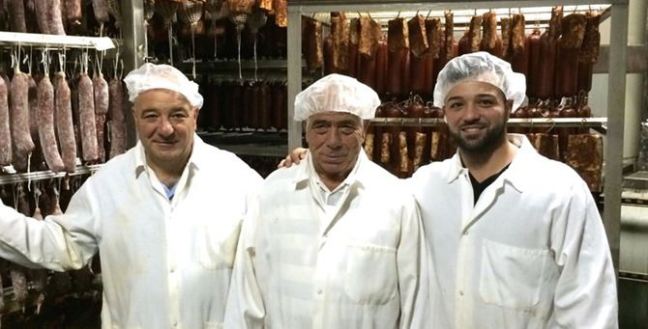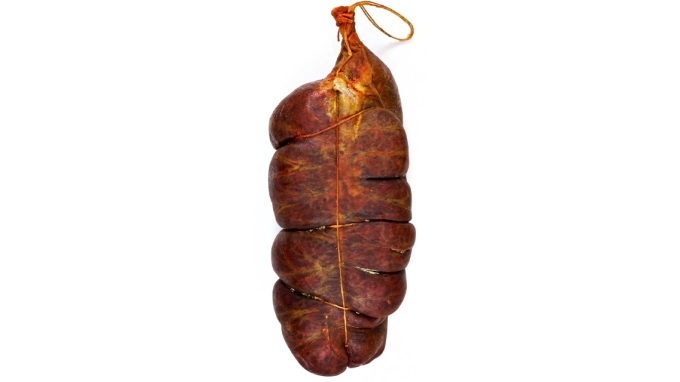Whether lovingly schmeared across golden crostini, or spooned into a sizzling pan to lay the foundation for any number of southern Italian pasta sauces, there is little doubt that if served outside its native Calabria, the unique spreadable salami evokes curiosity, and sometimes controversy.
Historically, ‘nduja was produced by peasants from the leftover parts of a recently slaughtered hog, after the prized market cuts had been first offered to the ruling classes. Today, in the area of Spilinga in Calabria, they specialize in the craft of ‘nduja. Similar to many traditional pork salami, ‘nduja has been improved by only using whole muscle cuts like jowl, belly, and shoulder. About a decade ago, American producers of cured meat became aware of this esoteric southern Italian specialty, and started to create and market their own interpretations. Unfortunately, without a true understanding of how it is produced, these products bore very little resemblance to authentic ‘nduja. There were, and still exist, many versions that take advantage of the increasing promotional value of the term ‘nduja, but are made by using the trim from already cured meat and pureeing them into a ready to eat paste, and others which go a step further and actually mix old and waste pieces of spicy salami which after being pureed, are mixed with acid, tomatoes, and sugar; aka: ketchup!

About 50 years ago, Agostino Fiasche left his homeland of Spilinga, and emigrated to America. Bringing with him his family’s traditions of hospitality, and food production, by the mid 80s he and his wife opened Agostino’s Ristorante Gustafino in Chicago. Among many of the traditional foods that Agostino and his family continued to produce was ‘nduja. The craft of butchery and salumi production has always been a valued part of the Calabrian heritage, and many Calabrian immigrant families in America still gather together once a year to make the traditional products of their home region, like salssicia (dry sausage), soppressata, capicola, and in the case of the Fiasches, ‘nduja. For this reason, it is extremely rare that any family from south of Tuscany would consider making artisan salumi for the wholesale market. Actually, other than the Fiasche family, who started “Nduja Artisan” (now “Tempesta Artisan Salumi”) in 2012, there are none. Since Calabrians have their own homemade supply enough for their family for the year, why sell it? As for the purchase of salumi produced by northern Italians, available for purchase, why buy it when you know how to make it better?

Three Generations of ‘Nduja Artisans… (from left Agostino Fiasche, his father, Antonio Fiasche Sr. and Agostino’s son, Antonio ”Tony” Fiasche)
‘Nduja is a simple recipe, and is made like any other fermented and dry cured spicy salami. Fresh pork muscle and fat are ground together, mixed with a puree of chilies for the desired amount of heat, seasoned with salt, stuffed into casings and allowed to ferment. Finally, depending on the diameter of the casing, the ‘nduja salami are slowly dried over a period of weeks to upwards of 6 months or more. Like any other salami, this drying or aging period draws out moisture so that it is eventually safe to store without refrigeration. After this aging period, most salami become hard, are able to hold shape and can be sliced thinly. On the other hand, because of higher fat content, plus the softening effect that Calabrian chilies have on fat, even once the proper amount of moisture has been removed, ‘nduja will remain soft. Any additional drying will intensify the flavor, but it will never become firm.

In 2012, after tasting the ‘nduja-like products available by American salumi producers, Agostino and his son, Antonio decided it was important to present an authentic ‘nduja to the American market. The father and son team felt obliged to honor their family’s heritage by starting a salumeria focused on making the real ‘nduja. In Agostino’s words, “‘Nduja is a salami. It’s made from only three ingredients: fresh pork, Calabrian chilies, and sea salt. If it has anything else, or is made any other way, it cannot be ‘nduja!” Initially named “Nduja Artisans”, by 2019, after much praise and awards had been bestowed on many other products in their extensive line of salumi, including back to back sofi gold wins for finocchiona and culatello, as well as a bronze win for Wagyu Bresaola, the family decided to change the company name to “Tempesta Artisan Salumi”. Nduja is still at the heart of the company, though, and being their top seller, will likely always be their flagship product.

Centered on their original mission to bring the genuine experience of this unique Fiasche family tradition to the national audience, they start with fresh whole muscle cuts, not scraps of cured meat, no off cuts, no organs, and still only the best heritage pork they can buy. Considering the chilies, they tone down the heat a bit. Unlike the version that Agostino’s father, Antonio Sr still makes at 84 in his home in Spilinga, which will light your mouth on fire, the ‘nduja produced by Tempesta Artisan Salumi is still spicy, but not quite as hot as Calabrians may be familiar with. It is hot, but balanced, so you won’t be reaching for a glass of water right away, and it will not interfere with other flavors on your plate.
Tempesta makes a 6 ounce “grab-and-go” sized retail package, one-pound units for foodservice, aged for about a month, and also produces the traditional “Orba” which takes a few months to age because it is encased in the tradition hog middle cap casing. This is the product you are likely to recognize hanging from the ceiling from every salumeria in Spilinga. The “Orba” can weigh anywhere from three to seven pounds, and even some custom ‘nduja which are aged in a stitched natural casing and can weigh more than 40 pounds!
The exact origins of Nduja are still a mystery, though there are a few theories regarding early production and where the name ‘nduja came from…
- The name Nduja may be derived from the word “Enduille”, and conveyed that way during the initial French occupations of Calabria
- Salam d’la Duja, “la duja” or “la doha” from the Piemontese dialect for clay pot where salami is initially dried, then preserved under fat in a basin or vase. This is another rare use of the letter “J” in the Italian language. The letter “J” is not generally considered part of the Italian alphabet, and may have contributed to the unique spelling of ‘nduja.
- The Spanish tradition for preserving meat like salami, was in Calabria since before the time of Columbus, through the end of the Arogonian periods leading up to the rule of the rule of the Bourbons. The Spanish introduced chilies to all of Europe and Asia following their discovery in the New World in the late 15th The Spanish were also curing meats throughout their history, though the spreadable version of spiced salami, Sobrasada (from Majorca) may or may not have preceded Nduja, and it is certainly possible that they are linked due to trade amongst all those under Aragon rule, which started in the early 11th century in Majorca, and the 15th Century in Calabria. This led to the subsequent rule by the French Bourbons of both regions.
So, it seems likely there was an evolution of spreadable salami over time, with chilies of course being introduced to both areas around the same time, and may certainly have come after a tradition of preserving meat was already established.
If the first question posed by someone encountering ‘nduja for the first time is “What is that?”, typically, the next question is, “How do you use it?” The fact that ‘nduja is a particularly regional product, often causes people to think it is only useful in exclusively Calabrian cuisine. Whereas, due to its uniquely spreadable texture, and the exclusive use of Calabrian chilies as seasoning, ‘nduja is actually much more versatile than any other salami. The soft texture allows ‘nduja to be incorporated into any liquid without any need for a knife, as you would have to chop a typical hard salami. Also, the deep flavors developed during the curing time, means that adding the product last minute to any dish will create the illusion that the spiciness was cooked into the dish from the beginning. Chefs who understand this will quickly replace the red pepper flakes on their dining room tables with a small jar of Nduja mixed with oil to a pourable texture guests can easily mix into their dish for a deep, robust spiciness. There is a plethora of chilies produced around the world, and often the intensity, depth of burn, and particular flavor profile is associated exclusively with the given region’s cuisine. Calabrian chilies, however connected with the particular flavors of Calabrian gastronomy, can be used in cuisines around the world without changing the inherent ethnicity of a dish. The heat of a spicy Calabrian chili falls squarely balanced on the palate, and though will build a slow burn, has a distinctive sizzle when it first touches the tongue. ‘Nduja has become popular in Japanese restaurants, as an accompaniment to ramen or brushed on sashimi, used as an alternative seasoning in picadillo for empanada filling, used as a marinade for meat or vegetables, and can be formed around a scotch egg before frying. ‘Nduja Pannacotta is a top selling gelato served at Tempesta Market, the Fiasche’s deli in Chicago. Who thought meat could be used as a marinade, let alone salami for dessert?

Keeping it real, didn’t we always suspect that there must be spreadable salami out there? After all, why would anyone use the term hard salami, without at least subconsciously recognizing the existence of soft salami???

